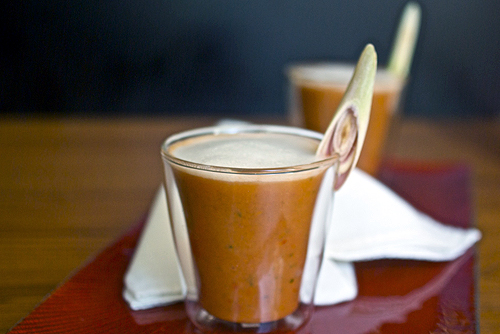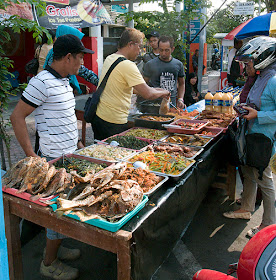Summer is a great time to visit the farmers market in Sacramento. Besides an abundance of stone fruits such as peaches, nectarines, and plums, there are also all the summer vegetables. The variety of tomatoes now available is astounding, and I decided to use some of those in this gazpacho. Happening upon some vibrant purple bell peppers, I chose to include those in the soup as well. Unfortunately, they didn't add much to the appearance of the gazpacho, and I didn't think they tasted quite as good as regular bells. The kaffir lime leaves which are from a tree we have growing in our back yard were a nice addition to the mix. Kalamansi limes spark the soup with a dash of zing.
(makes approximately 6 four to six ounce servings)
1 1/4 pounds of vine-ripened tomatoes (I used a mix of red and green zebras)
2 purple bell peppers, seeded and chopped
1 persian cucumber, seeded and peeled
2 shallots, peeled and chopped
1 to 2 cloves of garlic, peeled
1/3 to 1/2 cup olive oil
1--2 TBS rice vinegar
juice of 3 kalamansi limes
4 kaffir lime leaves, center vein removed, finely chopped
1 hot chile, seeded and chopped
salt and pepper to taste
3/4 cup water
two stalks of lemongrass, pale whitish bulb only, chopped
1 TBS lecithin
To make the gazpacho, quarter the tomatoes and press the seeds into a coarse mesh strainer set over a bowl. Put all the ingredients into a blender. Add the liquid collected from the drained seed pulp. Puree the mixture and chill in the refrigerator.
To make the lemongrass foam, puree the lemongrass and water in a blender. Allow to sit for at least several hours before straining the lemongrass from the liquid. Chill the liquid and add the lecithin. Using a stick blender mix the liquid until a light froth forms on the surface.
To serve, pour the gazpacho into four to six ounce glasses and spoon on a layer of the lemongrass foam.








